French actress Dolly Davis (1896-1962) was a very popular comédienne in the 1920s. She was often paired with André Roanne, and they even performed in a film simply called Dolly (Pierre Colombier, 1928).

French postcard in the 'Les Vedettes de Cinéma' Series by A.N., Paris, no. 112. Photo: G.L. Manuel Freres.
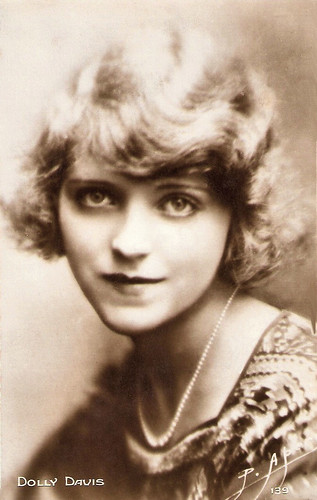
French postcard by Cinémagazine-Edition, Paris, no. 139. Photo: P. Apers.
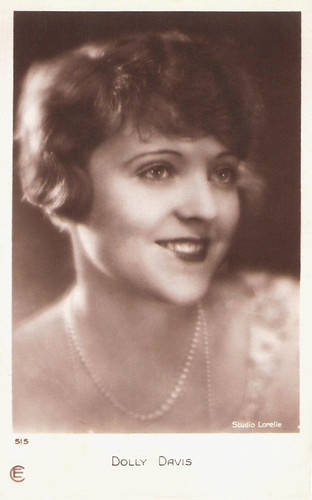
French postcard by Cinémagazine-Edition, Paris, no. 515. Photo: Studio Lorelle.
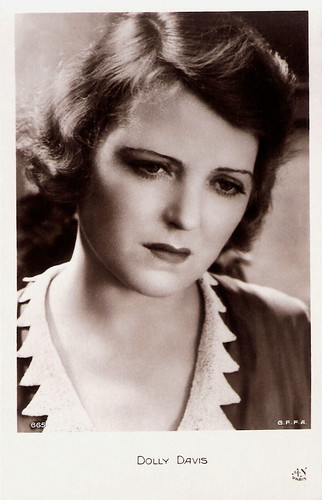
French postcard by A.N., Paris, no. 665. Photo: G.F.F.A.

French postcard by Edition Chantal, Paris, no. 77.
Dolly Davis was born Julienne Alexandrine David in the twentieth arrondissement of Paris, France, in 1896. The ravishing young girl posed for painters before making her film debut.
She already made her first film in 1919: La bourrasque/The Gust of Wind (Charles Maudru, 1919). She followed it up with Un conte de Noël/A Christmas Story (?, 1920) and Les étrennes à travers les âges/New Year's Gifts Through the Ages (Pierre Colombier, 1920).
She was much beloved in films such as the serial Vidocq (Jean Kemm, 1922) starring René Navarre as Vidocq, Genevieve (Léon Poirier, 1923) with Pierre Blanchar, Paris (René Hervil, 1924) with Marie Bell, and Mon frères Jacques/My Brother Jacques (Marcel Manchez, 1925) with Enrique Rivero.
A highlight was the fairytale-like Le voyage imaginaire/The Imaginary Voyage (René Clair, 1925) with Albert Préjean. Another success was Paris en cinq jours (Pierre Colombier, Nicolas Rimsky, 1926), a comedy about Americans in Paris.
With André Roanne, she appeared in the light comedy La petite chocolatière/The Chocolate Girl (René Hervil, 1927) and La femme du voisin/The Neighbour's Wife (Jacques de Baroncelli, 1928).
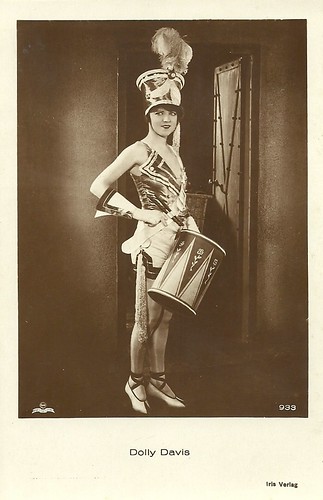
Austrian postcard by Iris Verlag, no. 933. Collection Didier Hanson.
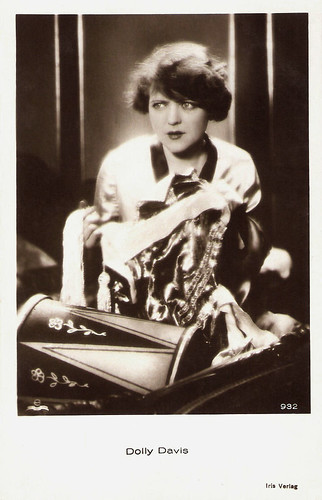
Austrian postcard by Iris Verlag, no. 932.
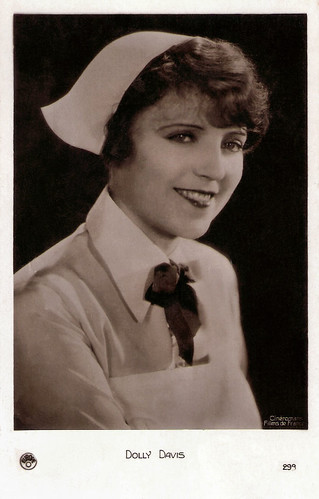
French postcard by Europe, no. 299. Photo: Cinéromans / Films de France.
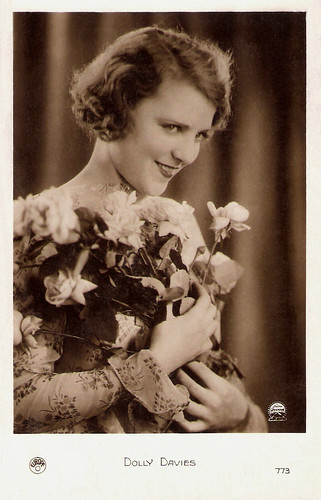
French postcard by Europe, no. 773. Photo: Paramount.
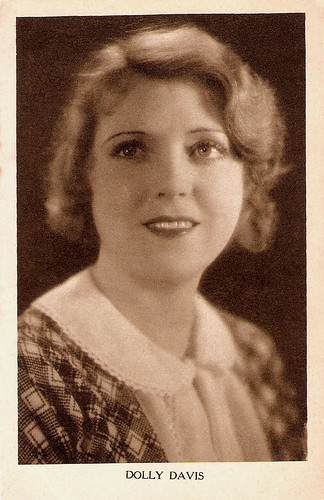
Belgian postcard by N.V. Universum, Antwerpen.
In 1928 Dolly Davis played in the American silent film Lights of Paris, shot in Paris and directed by Pierre Hemp. She played a young French girl from a small town who runs away to Paris to gain fame and fortune in the nightclub circuit.
In the late silent era, Davis also performed in various German films like Fraulein Josette - Meine Frau/A Marriage of Convenience (Gaston Ravel, 1926), Tingel tangel (Gustav Ucicky, 1927) with Paul Hartmann, Verirrte Jugend/Misled Youth (Richard Löwenbein, 1928), Frauenraub in Marokko/The Love of a Sheik (Gennaro Righelli, 1928) opposite Vladimir Gajdarov, Die weisse Rosen von Ravensberg/The White Roses of Ravensberg (Rudolf Meinert, 1929) starring Italian diva Diana Karenne, and a film directed by actress Olga Tschechowa: Der Narr seiner Liebe/Fool For Love (1929), starring Michael Chekhov.
When sound came along, Davis starred in La dernière berceuse (Jean Cassagne, Gennaro Righelli, 1930), the French language version of the first Italian sound film, La canzone dell'amore/The Song of Love (Gennaro Righelli, 1930), in which she played a young student who had to break off her engagement because of a baby her mother had with a stranger and left to her when she died. Seeing her life shattered, she tried to commit suicide, but her fiancé arrived in time. She followed this with the French comedy Un trou dans le mur (René Barberis, 1930) with Jean Murat.
More little-known French sound films followed including Gagne ta vie/Earn Your Living (André Berthomieu, 1931), Brumes de Paris/Mists of Paris (Maurice Sollin, 1932), Un train dans la nuit/A Train in the Night (René Hervil, 1934), and Bichon (Fernand Rivers, 1935), in which all the members of a family become agitated around a baby.
Davis reunited with her husband André Roanne in the sentimental comedy L'école des vierges/The Virgin School (Pierre Weill, 1935), in which she was convinced that he was cheating on her and decided to do the same, but the irreparable was avoided in time.
After Bar du sud/Southern Bar (Henri Fescourt, 1938) starring Charles Vanel, Dolly Davis retired. She was 42. From then on, she dedicated her time to painting, and she died in 1962 in Neuilly-sur-Seine, France.

French postcard. Photo: Studio Lorelle. Caption: "Si Paris vous attire, Campari vous retient."
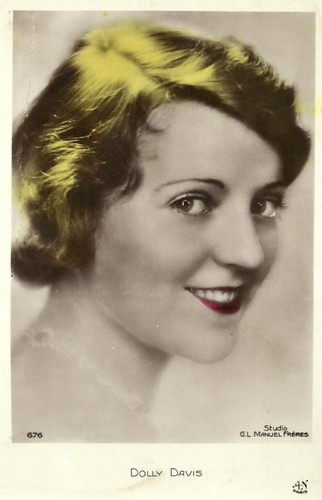
French postcard by A.N., Paris, no. 676. Photo: Studio G.L. Manuel Frères.
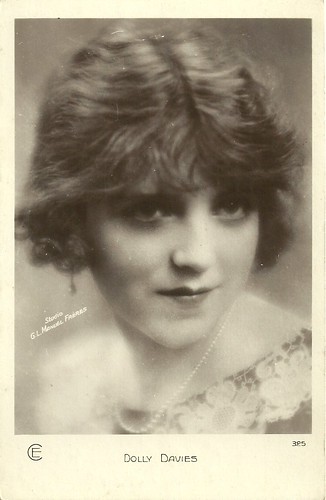
French postcard by Editions Cinémagazines, no. 325. Photo: Studio G.L. Manuel Frères.
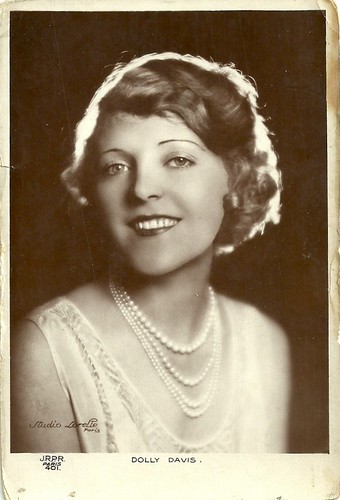
French postcard by J.R.P.R., Paris, no. 401. Photo: Studio Lorelle, Paris.
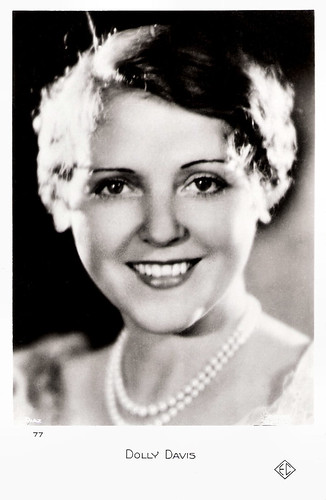
French postcard by EC (Editions Chantal), Paris, no. 77. Photo: Piaz.
Scene from Le voyage imaginaire/The Imaginary Voyage (1925). Source: Maxence Cyrin (Cinemix).
Sources: Thomas Staedeli (Cyranos), Gary Richardson (CineArtistes.com - French), Wikipedia (French), and IMDb.
This post was last updated on 3 December 2023.

French postcard in the 'Les Vedettes de Cinéma' Series by A.N., Paris, no. 112. Photo: G.L. Manuel Freres.

French postcard by Cinémagazine-Edition, Paris, no. 139. Photo: P. Apers.

French postcard by Cinémagazine-Edition, Paris, no. 515. Photo: Studio Lorelle.

French postcard by A.N., Paris, no. 665. Photo: G.F.F.A.

French postcard by Edition Chantal, Paris, no. 77.
The imaginary voyage
Dolly Davis was born Julienne Alexandrine David in the twentieth arrondissement of Paris, France, in 1896. The ravishing young girl posed for painters before making her film debut.
She already made her first film in 1919: La bourrasque/The Gust of Wind (Charles Maudru, 1919). She followed it up with Un conte de Noël/A Christmas Story (?, 1920) and Les étrennes à travers les âges/New Year's Gifts Through the Ages (Pierre Colombier, 1920).
She was much beloved in films such as the serial Vidocq (Jean Kemm, 1922) starring René Navarre as Vidocq, Genevieve (Léon Poirier, 1923) with Pierre Blanchar, Paris (René Hervil, 1924) with Marie Bell, and Mon frères Jacques/My Brother Jacques (Marcel Manchez, 1925) with Enrique Rivero.
A highlight was the fairytale-like Le voyage imaginaire/The Imaginary Voyage (René Clair, 1925) with Albert Préjean. Another success was Paris en cinq jours (Pierre Colombier, Nicolas Rimsky, 1926), a comedy about Americans in Paris.
With André Roanne, she appeared in the light comedy La petite chocolatière/The Chocolate Girl (René Hervil, 1927) and La femme du voisin/The Neighbour's Wife (Jacques de Baroncelli, 1928).

Austrian postcard by Iris Verlag, no. 933. Collection Didier Hanson.

Austrian postcard by Iris Verlag, no. 932.

French postcard by Europe, no. 299. Photo: Cinéromans / Films de France.

French postcard by Europe, no. 773. Photo: Paramount.

Belgian postcard by N.V. Universum, Antwerpen.
Tingel tangel
In 1928 Dolly Davis played in the American silent film Lights of Paris, shot in Paris and directed by Pierre Hemp. She played a young French girl from a small town who runs away to Paris to gain fame and fortune in the nightclub circuit.
In the late silent era, Davis also performed in various German films like Fraulein Josette - Meine Frau/A Marriage of Convenience (Gaston Ravel, 1926), Tingel tangel (Gustav Ucicky, 1927) with Paul Hartmann, Verirrte Jugend/Misled Youth (Richard Löwenbein, 1928), Frauenraub in Marokko/The Love of a Sheik (Gennaro Righelli, 1928) opposite Vladimir Gajdarov, Die weisse Rosen von Ravensberg/The White Roses of Ravensberg (Rudolf Meinert, 1929) starring Italian diva Diana Karenne, and a film directed by actress Olga Tschechowa: Der Narr seiner Liebe/Fool For Love (1929), starring Michael Chekhov.
When sound came along, Davis starred in La dernière berceuse (Jean Cassagne, Gennaro Righelli, 1930), the French language version of the first Italian sound film, La canzone dell'amore/The Song of Love (Gennaro Righelli, 1930), in which she played a young student who had to break off her engagement because of a baby her mother had with a stranger and left to her when she died. Seeing her life shattered, she tried to commit suicide, but her fiancé arrived in time. She followed this with the French comedy Un trou dans le mur (René Barberis, 1930) with Jean Murat.
More little-known French sound films followed including Gagne ta vie/Earn Your Living (André Berthomieu, 1931), Brumes de Paris/Mists of Paris (Maurice Sollin, 1932), Un train dans la nuit/A Train in the Night (René Hervil, 1934), and Bichon (Fernand Rivers, 1935), in which all the members of a family become agitated around a baby.
Davis reunited with her husband André Roanne in the sentimental comedy L'école des vierges/The Virgin School (Pierre Weill, 1935), in which she was convinced that he was cheating on her and decided to do the same, but the irreparable was avoided in time.
After Bar du sud/Southern Bar (Henri Fescourt, 1938) starring Charles Vanel, Dolly Davis retired. She was 42. From then on, she dedicated her time to painting, and she died in 1962 in Neuilly-sur-Seine, France.

French postcard. Photo: Studio Lorelle. Caption: "Si Paris vous attire, Campari vous retient."

French postcard by A.N., Paris, no. 676. Photo: Studio G.L. Manuel Frères.

French postcard by Editions Cinémagazines, no. 325. Photo: Studio G.L. Manuel Frères.

French postcard by J.R.P.R., Paris, no. 401. Photo: Studio Lorelle, Paris.

French postcard by EC (Editions Chantal), Paris, no. 77. Photo: Piaz.
Scene from Le voyage imaginaire/The Imaginary Voyage (1925). Source: Maxence Cyrin (Cinemix).
Sources: Thomas Staedeli (Cyranos), Gary Richardson (CineArtistes.com - French), Wikipedia (French), and IMDb.
This post was last updated on 3 December 2023.
No comments:
Post a Comment